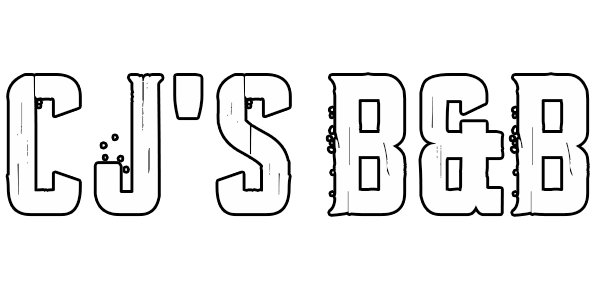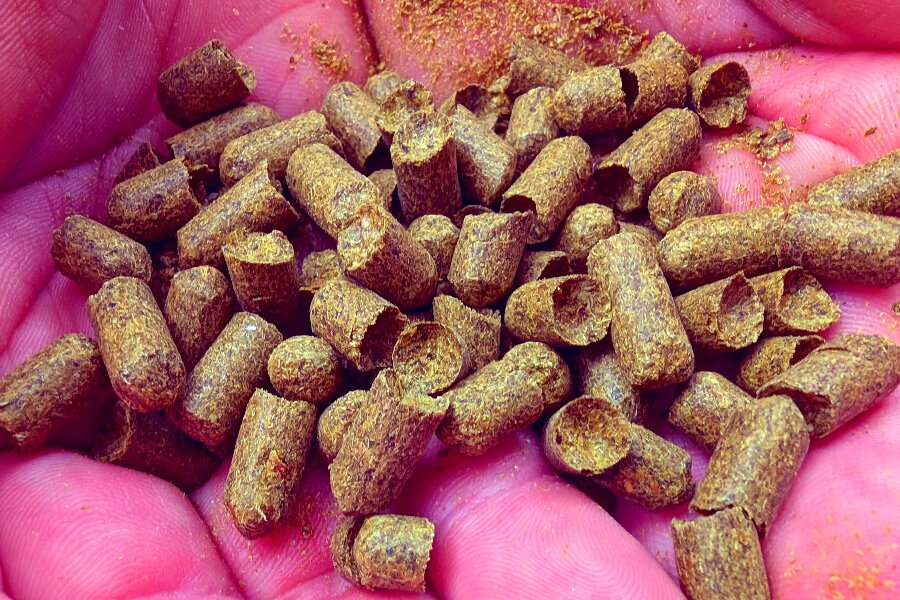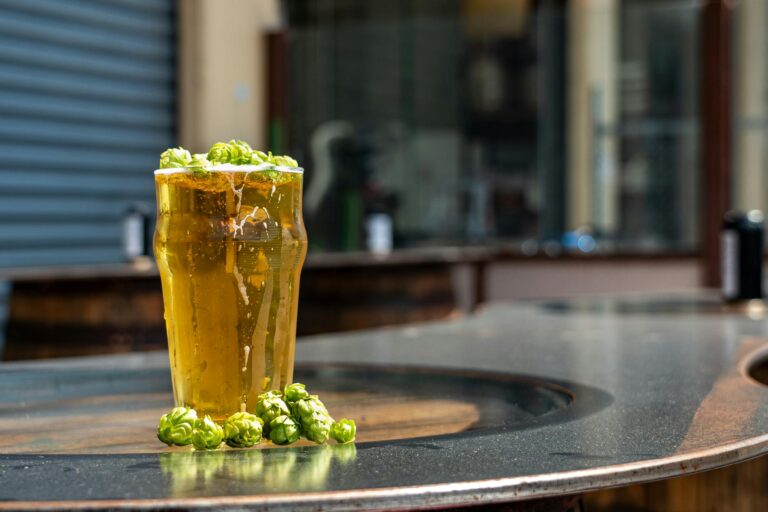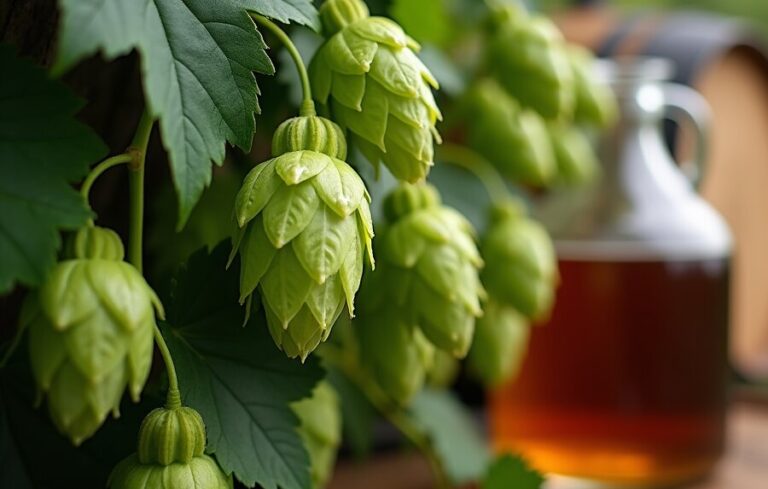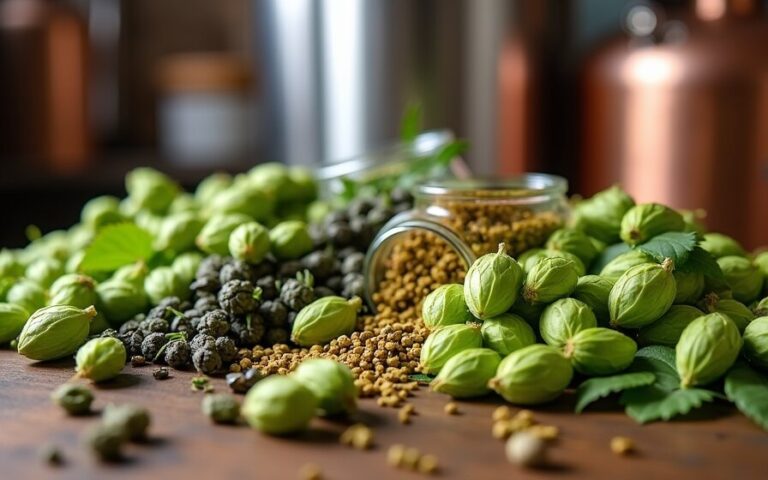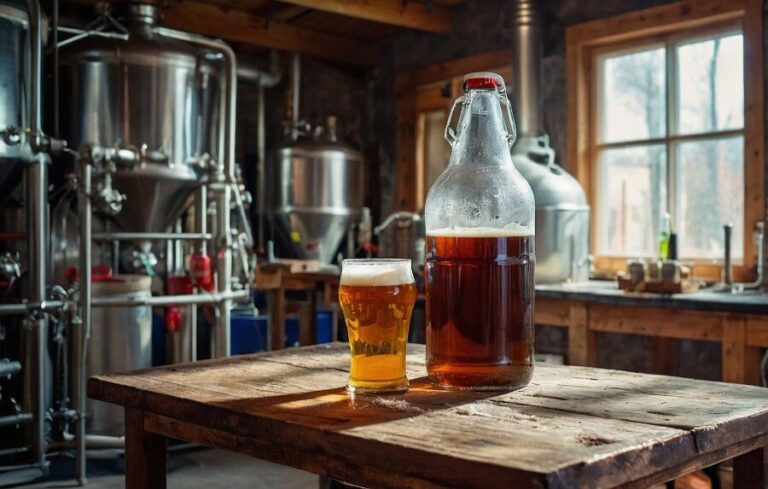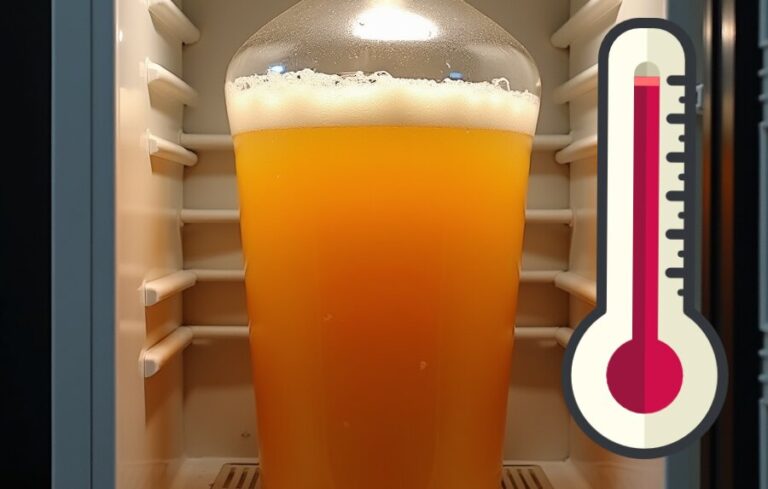Our evaluations and product assessments are conducted using a thorough and unbiased approach. Should you choose to buy any items through our provided links, we might receive a commission Read our disclosures.
Understanding Bittering Hops
Role of Bittering Hops For Homebrewing
Bittering hops play a crucial role in homebrewing. They are primarily used to impart bitterness to beer, which helps to balance the sweetness of the malt and the alcohol content. I often rely on bittering hops during the early stages of the boil to achieve the desired bitterness in my brews. These hops are high in alpha acids, which are the main bittering agents in hops.
Using bittering hops not only enhances the drinkability of the beer but also contributes to its stability. The iso-alpha acids formed during the boiling process possess antibacterial qualities, which can help increase the shelf life of my finished beer. For a deeper dive into hop varieties, check out our guide on the best hops for homebrewing.
| Key Functions of Bittering Hops |
|---|
| Impart bitterness to balance malt sweetness |
| Increase drinkability of beer |
| Stabilize beer, enhancing shelf life |
Alpha Acids in Hops
Alpha acids are the principal components found in the lupulin of hop cones. They are expressed as a percentage of the total weight of the hop and exist as complex molecules. When heated during the brewing process, alpha acids undergo isomerization to become iso-alpha acids, which are soluble in beer and provide the characteristic bitterness (Beer and Brewing).
The alpha acid content is measured in a laboratory, and the resulting bitterness of the beer is quantified in International Bitterness Units (IBUs). This measurement is essential for brewers like me to formulate recipes that achieve the desired level of bitterness. Longer boil times lead to more isomerization of alpha acids, which increases the bitterness in the final product (Beer Maverick).
| Alpha Acid Characteristics |
|---|
| Main bittering agent in hops |
| Expressed as a percentage of hop weight |
| Measured in IBUs in the finished beer |
In conclusion, understanding the role of bittering hops and the significance of alpha acids is essential for any homebrewer. By selecting the right varieties and knowing how to utilize them effectively, I can create a well-balanced and enjoyable beer. For more on hop usage, explore our article on hop utilization in homebrewing.
Bittering Hop Varieties
In my journey of homebrewing, I’ve often found that the choice of hops can significantly impact the final product. Bittering hops play a crucial role in balancing the sweetness of the wort and contributing to the overall flavour profile of the beer. Here, I’ll explore the different varieties of bittering hops, which are classified based on their alpha acid content.
Low-Alpha Bittering Hops
Low-alpha bittering hops are typically characterized by an alpha acid content ranging from 2.5% to 6%. While they provide some bitterness, their primary role is often more about aroma and flavour than strong bitterness. These hops are usually added later in the brewing process, which allows for a more nuanced flavour profile without overwhelming the beer with bitterness.
| Hop Variety | Alpha Acid Content (%) | Common Uses |
|---|---|---|
| East Kent Goldings | 4.5 – 6.0 | English Ales |
| Fuggle | 4.0 – 5.0 | English Ales |
| Saaz | 3.5 – 5.0 | Lagers and Pilsners |
These varieties can be useful if I want to create a balanced beer that has mild bitterness along with delightful aroma notes.
High-Alpha Bittering Hops For Homebrewing
High-alpha bittering hops have an alpha acid content that ranges from 10% to 15%. These hops provide a more pronounced bitterness and are often used early in the boil to counteract the sweetness of the wort. This is crucial for achieving that perfect balance in my homebrew.
| Hop Variety | Alpha Acid Content (%) | Common Uses |
|---|---|---|
| Columbus | 12.0 – 15.0 | IPAs and Stouts |
| Chinook | 12.0 – 14.0 | Pale Ales and IPAs |
| Nugget | 10.0 – 14.0 | Various Beer Styles |
Using high-alpha hops allows me to achieve the desired bitterness while keeping the overall hop usage efficient.
Super Alpha Bittering Hops For Homebrewing
Super alpha bittering hops boast an impressive alpha acid content ranging from 14% to 18%, with some experimental varieties even reaching 22% Beer and Brewing. These hops are ideal for brewers looking to maximize bitterness with minimal quantity.
| Hop Variety | Alpha Acid Content (%) | Common Uses |
|---|---|---|
| Summit | 16.0 – 18.0 | IPAs and Imperial Ales |
| Apollo | 15.0 – 18.0 | IPAs and Lagers |
| Zeus | 14.0 – 17.0 | American Ales |
Super alpha hops can greatly enhance the bitterness of my beer while also contributing to the beer’s stability and shelf life due to the antibacterial qualities of iso-alpha acids Beer Maverick.
Choosing the right variety of bittering hops is essential for creating a balanced and flavourful homebrew. Knowing the differences between these hop types helps me better plan my brewing process and achieve my desired taste. For more insights on hop utilization, check out my guide on hop utilization in homebrewing. If you’re considering swapping hops, you might find useful tips in my article on hop substitutions for homebrewing.
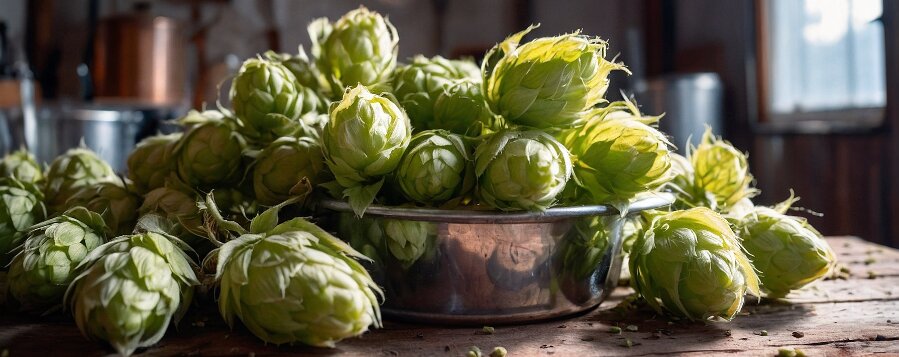
Factors Affecting Bitterness
When brewing my own beer, I’ve learned that several factors can significantly influence the bitterness of my final product. Understanding these factors helps me to achieve the desired balance in my brews. Here, I’ll discuss the time of addition, boil duration, and storage impact on bitterness.
Time of Addition
The timing of when I add hops during the boil is crucial. Hops added at different stages contribute varying characteristics to the beer. For instance, adding hops at the beginning of the boil primarily imparts bitterness, while hops added in the middle enhance flavour, and those added towards the end provide aroma (The Brew Hut).
| Time of Addition | Effect |
|---|---|
| Start of Boil | Maximum bitterness |
| Middle of Boil | Flavour enhancement |
| End of Boil | Aroma contribution |
Boil Duration
The duration of the boil also plays a significant role in determining the bitterness of the beer. A longer boil time increases the extraction of alpha acids from the hops, leading to greater bitterness. However, if I’m not careful, this can also cause the beer to become overly bitter or lose desirable hop flavours. Generally, a boil duration of 60 minutes is common for maximizing hop utilization, but I might adjust this based on the specific recipe and desired outcome.
| Boil Duration | Bitterness Impact |
|---|---|
| Less than 30 minutes | Reduced bitterness |
| 30 – 60 minutes | Balanced bitterness |
| More than 60 minutes | Increased bitterness |
Storage Impact on Bitterness
I’ve also discovered that how I store my hops can affect their bitterness. Hop alpha acid levels are highest at the point of harvest but diminish over time due to oxidation. To maintain their potency, I refrigerate or freeze my hops after harvest. Hops processed into pellets or concentrated extracts tend to retain their alpha acid levels better than whole leaf hops (Beer and Brewing). This means I need to pay attention to my hop storage methods to ensure I get the bitterness I want in my brews.
| Storage Method | Alpha Acid Preservation |
|---|---|
| Refrigeration | Delays oxidation |
| Freezing | Best preservation |
| Room Temperature | Accelerates degradation |
By considering these factors of time of addition, boil duration, and storage impact, I can better control the bitterness levels in my homebrewed beer. For additional information on optimizing hop usage, check out our articles on hop utilization in homebrewing and best hops for homebrewing.
Using Bittering Hops For Homebrewing
When I think about brewing my own beer, one of the most exciting aspects is experimenting with different hop varieties. Understanding the role of bittering hops is crucial for creating the perfect balance in flavour and aroma.
Bittering vs. Aroma Hops
Hops are incredibly versatile, and they can add bitterness, flavour, and aroma to my brews. The key difference between bittering hops and aroma hops lies in their alpha acid content and when I add them during the brewing process.
| Type of Hops | Alpha Acid Content | When to Add | Purpose |
|---|---|---|---|
| Bittering Hops | High | Beginning of the boil | Adds bitterness |
| Aroma Hops | Low | Late in the boil or dry hopping | Adds flavour and aroma |
| Dual-Purpose Hops | High | Anytime during the brewing process | Adds both bitterness and aroma |
Bittering hops are high in alpha acids and are usually added at the start of the boil to impart bitterness to the beer. In contrast, aroma hops have lower alpha acid content and are typically added later in the boil or during dry hopping to enhance the beer’s flavour and aroma (The Brew Hut, Beer Maverick).
Brewing Techniques with Bittering Hops
When I brew, the timing of hop additions is essential for achieving the desired characteristics. Here are some techniques I consider when using bittering hops:
Early Addition: I add bittering hops at the beginning of the boil to maximize the bitterness. This is where the alpha acids are isomerized, contributing to the beer’s overall bitterness profile.
Pre-Isomerized Hop Extracts: I sometimes use pre-isomerized hop extracts if I want to boost bitterness after fermentation. For example, adding just 200 mg of iso-alpha-acids can increase the bitterness of 20 L (5.3 gallons) of beer by 10 International Bitterness Units (IBU) (Brew Your Own).
Post-Fermentation Adjustments: If I need to adjust the bitterness after fermentation, I can make a hop extract. The solubility of iso-alpha-acids increases as pH decreases, allowing me to fine-tune the bitterness effectively (Brew Your Own).
By understanding how to effectively use bittering hops in my brewing process, I can create a well-balanced beer that showcases the flavours I enjoy. For more insights on selecting the right hops, check out our guide on best hops for homebrewing.
Experimenting with Bittering Hops
Experimenting with different types of bittering hops for homebrewing has become a crucial part of my brewing journey. Understanding how high and low alpha acid hops affect the final product, how to substitute them effectively, and my personal preferences has greatly enhanced my brewing skills.
Impact of High vs. Low Alpha Acid Hops
In my exploration, Ray Found conducted an experiment comparing high alpha acid hops, like Magnum, to low alpha acid hops, such as Saaz, while brewing a Vienna Lager. He found that tasters often struggled to distinguish between the two beers. Both were designed to achieve an International Bitterness Unit (IBU) of 28, yet the lab results showed the beer bittered with Magnum had an IBU of 18, while the one with Saaz reached 22 (Brülosophy).
The flavours and bitterness were surprisingly similar. I perceived the Magnum-bittered beer as slightly crisper with a cleaner bitterness, while the Saaz beer had a softer, rounder character. This led me to realize that early kettle hop additions might have minimal impact on flavour and aroma, which was an eye-opener for my brewing practices.
| Hop Type | IBU Achieved | Flavour Profile |
|---|---|---|
| Magnum | 18 | Crisp, clean bitterness |
| Saaz | 22 | Softer, rounded bitterness |
Substituting Bittering Hops
The experiment also highlighted the feasibility of substituting hops during brewing. As long as I adjusted for the alpha acid percentage, I found that hops with similar characteristics could be swapped without greatly affecting the overall taste. This flexibility has allowed me to experiment with what I have on hand and still achieve a great brew. For more insights on substitutions, check out our article on hop substitutions for homebrewing.
I noticed that the batch bittered with Magnum hops had poorer head quality compared to the Saaz batch. This was likely due to the foam-positive compounds present in the Saaz hops. Despite this, I generally prefer using Magnum for bittering because of its cost-effectiveness and the clean bitterness it imparts, which ultimately increases my yield.
Personal Impressions and Preferences
Through my brewing experiments, I’ve developed a personal fondness for certain hops based on my experiences. I tend to favor Magnum for its clean and pleasant bitterness, which aligns well with my brewing style. However, I remain open to experimenting with different hops, especially those that might yield unexpected flavours or aromas. My journey has taught me the importance of experimenting with various hop varieties to refine my palate and enhance my homebrew.
If you’re interested in exploring the different flavours hops can bring to your brew, consider checking our article on hop flavors in homebrewing. Each brewing session offers a chance to learn something new, and I encourage anyone passionate about homebrewing to embrace the experimentation process.
Maximizing Bittering Efficiency
When I’m brewing my own beer, maximizing the efficiency of bittering hops is essential for achieving the perfect balance of flavours and aromas. Here, I’ll share some insights on the cost-effectiveness of bittering hops, how to adjust bitterness levels, and the relationship between foam quality and bittering hops.
Cost-Effectiveness of Bittering Hops
Using bittering hops effectively can significantly impact my brewing costs. Hop varieties are often categorized based on their alpha acid content, which directly influences their bitterness contribution. Here’s a quick breakdown of hop categories:
| Hop Category | Alpha Acid Content (%) |
|---|---|
| Low-Alpha Aroma Varieties | 2.5% – 6% |
| Dual-Purpose Varieties | 6% – 10% |
| High-Alpha Bittering Varieties | 10% – 15% |
| Super Alpha Bittering Varieties | 14% – 18% |
Understanding these categories helps me select the right hops for my brewing needs. High-alpha hops may cost more upfront but can yield higher bitterness with less quantity, making them cost-effective in the long run. For more insights on selecting hops, check out our article on best hops for homebrewing.
Adjusting Bitterness Levels
Bitterness in beer is quantified in International Bitterness Units (IBUs), which are derived from the alpha acids in the hops. The alpha acid level of hops is crucial for formulating my recipes (Beer and Brewing). If I want to adjust bitterness levels after fermentation, one effective method is to use pre-isomerized hop extracts.
For instance, to increase the bitterness of 20 liters (5.3 gallons) of beer by 10 IBU, I only need 200 mg of iso-alpha acids (IAA). This can be a game-changer if I find my beer lacking in bitterness after fermentation (Brew Your Own).
Here’s a simple table that illustrates how much IAA can impact bitterness:
| Volume of Beer | Increase in Bitterness (IBU) | Amount of IAA Needed (mg) |
|---|---|---|
| 20 L (5.3 gal) | 10 | 200 |
| 20 L (5.3 gal) | 20 | 400 |
Foam Quality and Bittering Hops
Foam quality in my beer can also be influenced by the choice and quantity of bittering hops. The sensation of bitterness isn’t solely determined by the concentration of iso-alpha acids (IBUs). Factors such as malt flavours, residual extract, alcohol, and carbonation also play a significant role (Brew Your Own).
Higher gravity beers often require more hop bitterness for balance. Achieving the right foam quality enhances the overall drinking experience. A well-balanced beer with appropriate bitterness and good foam can leave a lasting impression.
By focusing on the cost-effectiveness of my hop choices, adjusting bitterness levels post-fermentation, and paying attention to foam quality, I can maximize the efficiency of the bittering hops I use in my homebrewing endeavors. If you’re interested in experimenting with hop varieties, don’t forget to explore hop substitutions for homebrewing and hop flavors in homebrewing.

